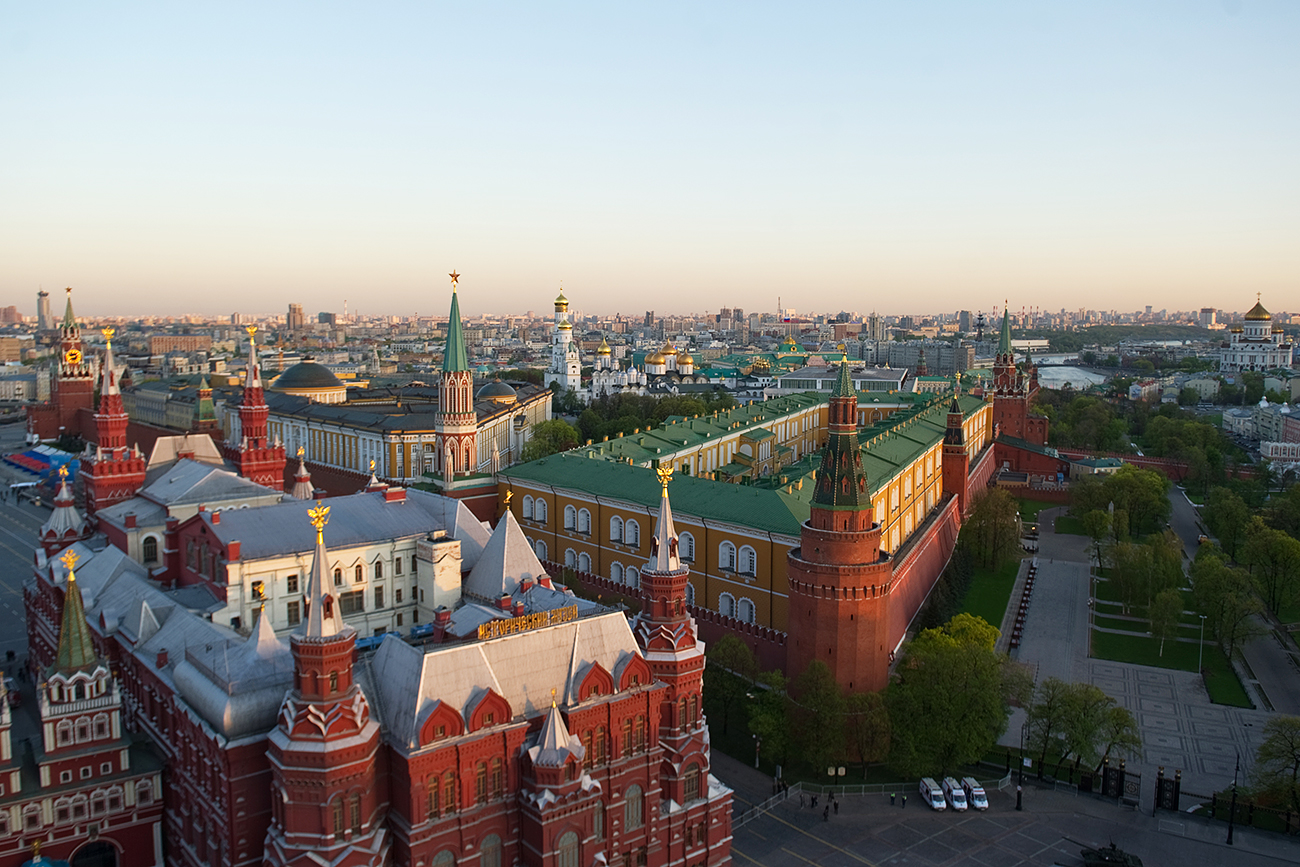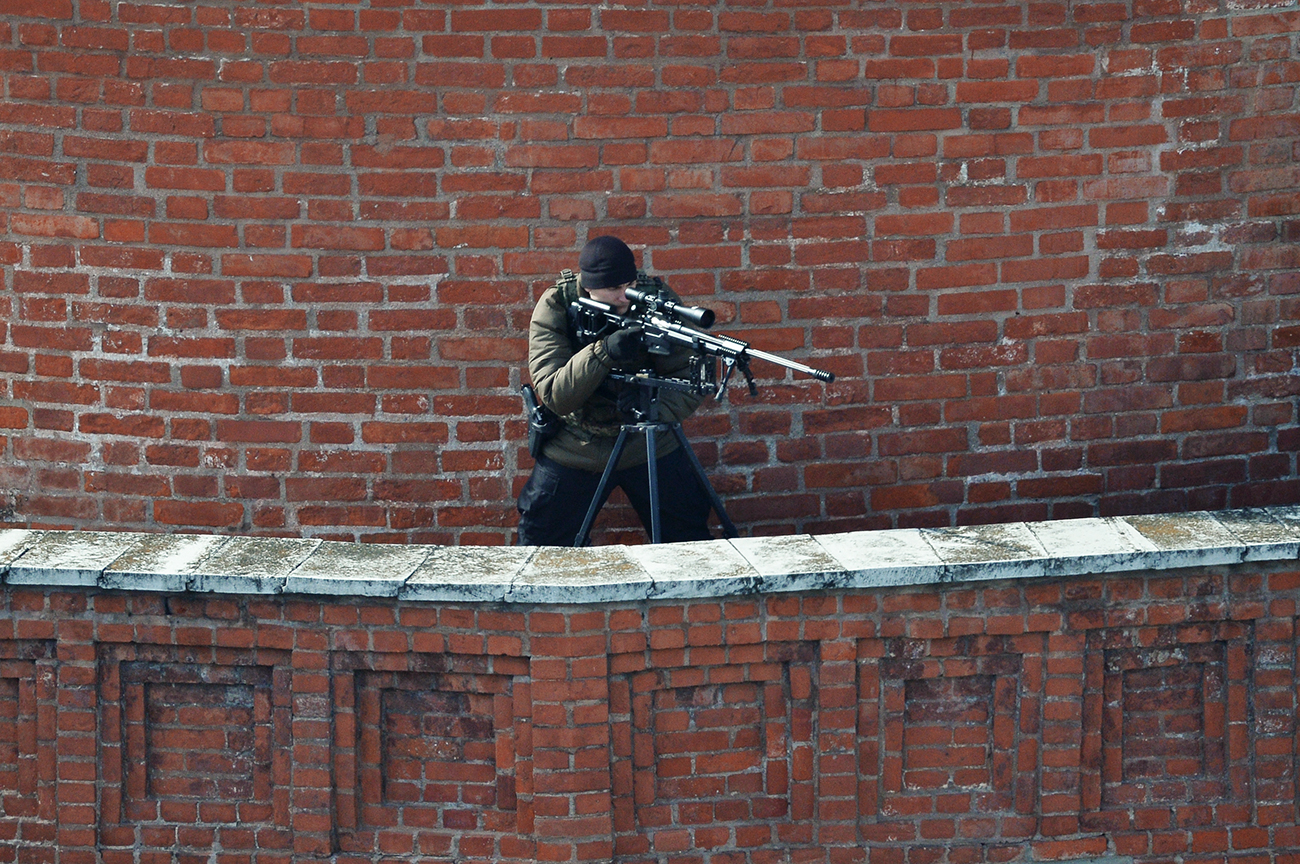Is it possible to break into the Moscow Kremlin?

If there is any major danger for people working in the Kremlin, the FSO can call upon local special forces, as well as a military unit with tanks and armed vehicles based in a Moscow suburb.
Alexander Vilf/RIA NovostiA banner apparently hangs on the Moscow Kremlin’s Arsenal Tower, and reads, "Feminism as the national idea." Two young ladies placed it there with flares burning in their hands. This powerful photo went viral on social media on March 8 (International Woman's Day), and was the strongest punch of the feminist protest against "male domination." No one has ever been capable of such audacity, able to break into the Kremlin.
Except it never happened. The photo was made using Photoshop. As the activists who had protested in the Kremlin and the Alexander Garden later admitted, their irresponsible colleagues posted fake photos. The unpleasant story not only ruined the demonstration’s credibility, but also proved that it’s impossible to illegally enter the Kremlin.
круто, конечно
— Feldman (@EvgenyFeldman) 8 марта 2017 г.
(автора фото не знаю, пришло в анонимной рассылке) pic.twitter.com/voo6InfX58
Cameras, sensors and fences
One of the first to doubt the photograph’s authenticity was Ilya Varlamov (in Russian), the popular Russian photographer and blogger. "It's difficult for me to believe that someone could have done something like that, considering the level of protection in the Kremlin," wrote Varlamov, remembering his own walks inside the fortress.
"Everywhere are sensors and cameras," noted Varlamov, and the photographs he posted indeed show that every few meters there are cameras on Kremlin walls. In addition, the walkways on top of the walls are blocked by gratings and fences. It’s impossible to walk on the wall, let alone climb up to the tower.
All the president's men
Varlamov also writes that, "at every step [on the Kremlin wall] you'll find Federal Protection Service (FSO) agents who'll immediately tackle any trespasser." The FSO is a special force that provides security for the country's top officials, and the president's official residence is their area of responsibility.
The FSO includes the Kremlin garrison, which is also called the Kremlin, or the President's Regiment. As one of the regiment members told (in Russian) the magazine The Village on condition of anonymity, the regiment consists of about 500 people. It includes five battalions, two of which are directly responsible for guarding the fortress. There are also honor guard units that stand on particularly important posts - by the Eternal Fire, and Lenin’s Mausoleum - and participate in parades.
The Village's source said that if the Kremlin is attacked, or if there is any major danger for people working there, the FSO can call upon local special forces, as well as a military unit with tanks and armed vehicles based in a Moscow suburb.
 A sniper at a Kremlin tower during the military parade to mark the 70th anniversary of Victory in the 1941-1945 Great Patriotic War. Source: Maksim Blinov/RIA Novosti
A sniper at a Kremlin tower during the military parade to mark the 70th anniversary of Victory in the 1941-1945 Great Patriotic War. Source: Maksim Blinov/RIA Novosti
Crack units
The FSO, however, is not limited to the Kremlin regiment, and it also includes agents who are directly responsible for the security of top Russian officials, as well as foreign leaders who visit the Kremlin. FSO agents undergo special training, and according to the film, How the Guards Work, this includes hand-to-hand combat and practicing the ability to shoot and neutralize a hostile target in a crowd of people.
Also, the agents thoroughly study all possible circumstances in which world leaders can be assassinated, analyzing the behavior of their foreign colleagues and training in similar situations. Before official meetings in the Kremlin, FSO agents pay particular attention to the security of the president's residence. Several days beforehand, the number of Kremlin museum visitors is restricted, and the agents repeatedly search the halls of the Grand Kremlin Palace, currently the location of important meetings, for explosives.
Sometimes, the FSO organizes full-fledged training sessions on Kremlin territory. For example, on Nov. 17, 2016, FSO agents, together with the police and the Russian National Guard, conducted a mock attack against the Kremlin by terrorists.
Forbidden territory
Security restrictions in the Kremlin not only concern towers and walls. All flights over the Kremlin are prohibited, including for quadrocopters, which often leads to the detainment of tourists. For example, in 2015 the FSO detained and fined German photographer Fritzsche Holger for having tried to take a photograph of the Kremlin using a drone.
Many people believe that the loss of GPS and GLONASS signals near the Kremlin is related precisely to the fight against drones. As the signals disappear, the navigational systems show that the user is located not by the walls of the Kremlin but in one of Moscow's airports. However, FSO representatives officially deny that they purposely suppress the signals.
Read more: Why is the Kremlin ‘transporting’ GPS users to Vnukovo airport?>>>
If using any of Russia Beyond's content, partly or in full, always provide an active hyperlink to the original material.
Subscribe
to our newsletter!
Get the week's best stories straight to your inbox